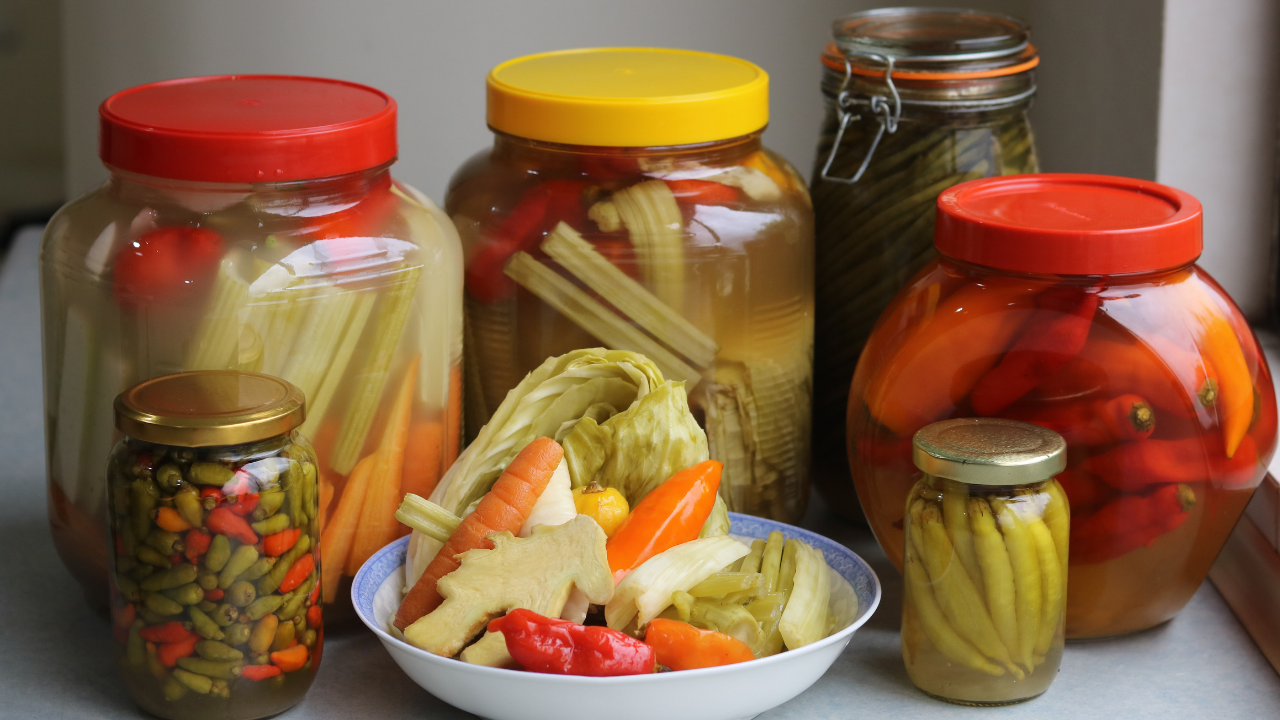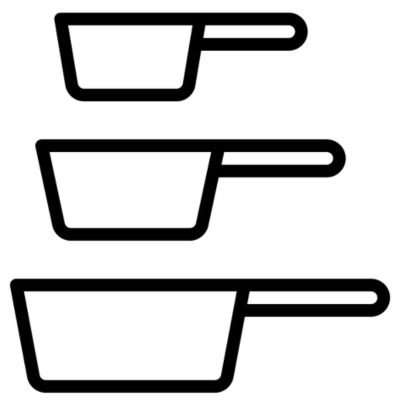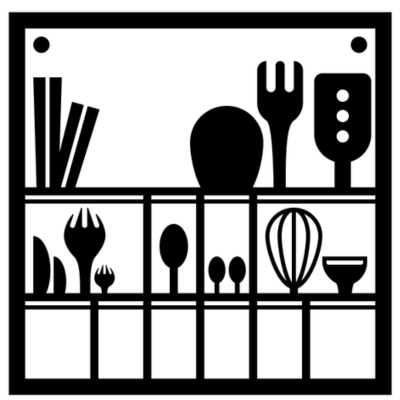Chinese Pickles
Rated 3.0 stars by 9 users
Category
Vegetarian
Author:

Ingredients
- 5 kg of water
- 380 grams of salt [It is better to use pickling salt
- 100 grams of sugar
- 3 grams of star anise
- 5 pieces of bay leaves
- 5 grams of cinnamon
- 10 grams of Sichuan peppercorn
- 5 kg of the vegetable mix Celery, cabbage, carrot, Chinese Turnip radish, long beans, chilies,
Directions
Tools & Containers
You want to use glass, ceramic or stainless steel material jar. Avoid aluminum, brass, iron, copper, and zinc containers, and utensils, which can react with the acid brine during fermentation. I got some glass jars with plastic or metal cover. Because the lid will not tough the brine directly so they are ok to use.
- Here, I want to talk about the traditional Chinese pickle jar. It is a fat ceramic container with a shoulder around the neck. And has a bowl upside down to cover the jar. This is the best thing to make Chinese pickle. It no transparent so the light will not go through, which allows the healthy fermentation to keep going. You can fill up the shoulder part with water and it will seal the jar completely. Also, it can automatically release the air during the pickling process. With this, you will have a higher chance to be successful. I could not find this thing in Ecuador. I do want to bring one from China but it is too heavy and delicate. They have it on Amazon. Well, if you can’t buy it, the regular jar will do a good job you just need to put a little extra effort into it.
- Before you use the container, you need to make sure it can be sealed completely. This is how I check it. Fill the jar with some water, cover the lid and turn it upside down. If you see there is not liquid dripping down, that means this jar is good to use. If the liquid is dripping slowly, do not use it. One of my pickle jars wasn’t sealed completely and it gets spoiled quickly which I will talk about it at the end.
- Make sure you wash the jar completely with soapy water. Rinse it several times. Then rinse it with boiled hot water one last time. Be careful don’t burn yourself. Put it on a clean towel upside down. Let it air dry or sundry.
- Also, clean everything that you will need for making Chinese pickle. Such as a big pot for boiling the brine, some trays that you will need for drying the vegetables, cutting board, knives, other utensils such as chopsticks, scissors, spatula. Let them air dry as well.
Brine & Spices
There are two basic categories of pickles, according to the types of solution. The first type is preserved in vinegar. They taste extremely sour due to the low salt content. Most of the bottled kosher cucumber pickles in the supermarket are preserved in vinegar. Chinese pickles are mostly soaked in a salt brine to encourage fermentation, which is the second category of pickles. It has a higher sodium content, tastes saltier and sour but not as sour as the first type. I grew up Chinese pickle. So this is what we are going to make today.
- Now let’s talk about the salt. It's best to use "pure" salt. Sea salt, pink salt, kosher salt—it doesn't matter as long as the label says it's pure salt. Table salt usually contains iodine and other additives to keep it from caking, which can cause clouding of the brine and discoloration of the pickles. It doesn't affect the ultimate safety of the pickles, but it makes them look bad. There is salt that is special for pickle, it is called pickling salt. They have it on Amazon. Here is the link if you want to buy it: Pickling salt: https://amzn.to/2Mpl3di.
- Also, the amount of salt you put in is adjustable. The salt and water ratio, although anywhere between 5-8% is good, I suggest you do a higher ratio in the beginning. For 5 kg of water, I used 380 grams of salt. That is about 7.6%. For Chinese pickle, we never throw the brine away unless it is completely spoiled. Some families have the brine that has been pass by few generations. As long as the brine is not spoiled, you can keep it forever. What we are making today is the beginning brine. Higher salt content, in the beginning, keeps the bad bacteria from growing. After a few times using, it will turn into an old brine which has a balanced amount of good bacteria. Those activities will keep the brine itself staying good. By that time, you can lower the salt amount.
- In a clean pot, pour in 5 kg of water. Although tab water will work, I did use bottled water just to avoid any uncertainty. Add 380 grams of salt and 100 grams of sugar. Sugar is optional. Some people like it slightly sweet; some people prefer not sugar. Depends on your taste. I also seasoned the brine with some spices: 3 grams of star anise, 5 pieces of bay leaves, 5 grams of cinnamon, 10 grams of Sichuan peppercorn. All these spices can be adjusted to your own preference. This is just how I like it.
- Cover this and bring it to a boil. Once is nice and bubbling, let it cook for another 10 minutes. Turn off the heat. Let it sit overnight with the lid on. For 2 purposes. Number 1 is to let it cool down completely. Second is that it will have enough time to soak the spices, you know, to maximize the fragrance.
Vegetables
These are the things that I am going to use today: celery, cabbage, long bean, Chinese turnip radish, carrot, ginger, 3 kinds of chilies. You can use whatever vegetables you like but I personally will avoid using leafy greens that will turn soggy after pickling such as lettuce, spinach, and baby bok choy.
- Wash, rub, and rinse all the vegetables under running water. Discard the parts that you don’t normally eat such as the tough end of the celery, the top of the carrot and the chili stem. Cut the vegetables into the size you like. Simply place them on a clean tray. Let it sundry 5 hours or air dry overnight, until there is no water on the surface.
- Next day, all the veggies are completely dried. The surface gets a little crinkle, also shrank a little bit. Check the cabbage, there is not water under knees and the leaves are soft. That is exactly what you want.
- Now you can start putting the vegetables into the jars. The cabbage goes in first because that is the biggest size. Then you use the smaller vegetables to fill up the empty space. You know, kind of like a puzzle. You want to maximize the use of the jar. One thing about chilies and peppers is that they do make the brine become spicy as the day goes by so you want to be careful when using it.
- Now the brine has been sitting overnight. You just go fish out all the spices. Pour it into the jar. Be sure to fill it all the way up close to the lid. That is the way how you keep the least amount of air inside. If there is too much air pack between the lid and the liquid, there is a higher chance it will get spoiled. Finish it with 2 tbsp of high alcohol content liquored. At least 30%. The higher, the better. My jar is 3.5 liter, if it is a small jar, you will need to use less alcohol.
- Ok, that is basically all the work for making Chinese pickles. Now you just put them in a dark place. Let them ferment for 20 days. In the first week, every 2 days you need to open the lid and let it air out for a few seconds. What happens is that during the fermentation, the bacteria creates lots of air which needs to be released. If you don't do that. They will inflate like an over shook cola. You do not want a mess like that. Well, it is not the end of the world. You just need to add a little more brine and fill it up again. Once you pass the first week or 2, depends on what type of veggies you are pickling, you don’t need to let it air out anymore unless you are adding new vegetables to the brine.
3 WEEKS LATER
All the pickles are done fermenting. There are no bubbles raising up anymore. The first week, you can really see lots of activities going on. Now it just peaceful. A successfully made pickle - The liquid should be clean, clear, shouldn’t be any weird stuff floating around. It should have a pleasant fermented pickle smell. It should not smell like alcohol at all. The pickle should have nice color, if it was green, they will turn into brown. But if it was if red or yellow, they should stay the same color.
- A good Chinese pickle, you can eat it right out of the jar. It is very crunchy, a little salty and has a unique pickle smell.
- They can be stored in the jar for about 5-6 months. You can use it for side dish, or cook with it. I will share some recipes in the future. Make sure you subscribe to channel so you don’t miss any recipe.
How to Keep Using the Brine Forever
Make sure you use clean tools to take the pickles out of the jar. This is very important because you don’t want to introduce any new bacteria into the jar.
- Then you will have empty space for the new vegetables. Adjust them to fit into the jar. Fill the jar with clean water all the way up to the lid again. The veggies always dilute the seasoning so you should also add some salt and sugar. The salt ratio should be 5-8% of the total weight of the new vegetables and new water. The sugar ratio should be 1-2% of the total weight of the new vegetables and new water.
- After 3 or 4 times adding new vegetables, you can start adjusting the balance between the saltiness and the sourness. Make sure it fits your taste. As long as you follow the rules that I talked about before. Make sure it is not spoiled, you can keep using the brine forever.
How does it look like when the brine is spoiled
I made 7 jars of pickles, only the jar that is not completely sealed is a little bad. There is some white stuff floating on top of the liquid, looks like some type of fungus. That is the bad bacteria. They will only grow on top of the liquid, that is where they can reach the oxygen. This just beginning of the spoiling. If you let it continue, it can be even worse and it will smell like alcohol.
How To Fix The Brine When It Is Spoiled
When you making fermented things, there will always be some uncertainties that are hard to predict. That happens and you either discard this whole batch of pickles or you still want to fix it. There is a way that my parent and my grandparents tough me. But I wouldn’t recommend that way because there is no official test to prove it is completely safe. Although I have done it this way and eaten it many times and I am still alive.
- You can use a spoon to fish out all the white fungus because the bad bacteria will only grow on top of the liquid.
- Fill up the jar with some new brine all the way up close to the lid again.
- Add 1 - 2 tbsp of high alcohol content liquor. The alcohol content needs to be at least 30%, the higher, the better.
- Cover the lid and put it back to a dark place.
- Come back in 2 days, if you see there is no more white stuff growing, that means this brine is fixed. If there is still fungus growing, you have to discard the whole batch of pickles.


























































